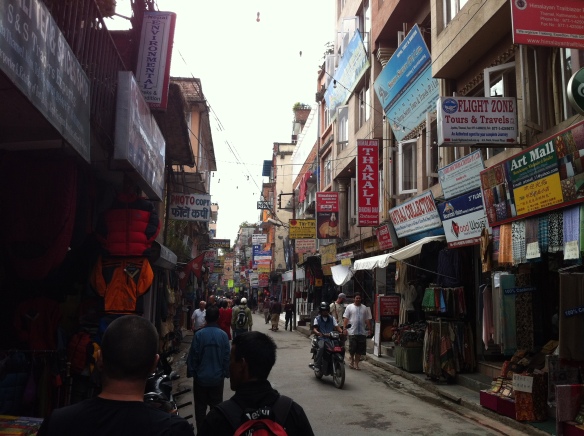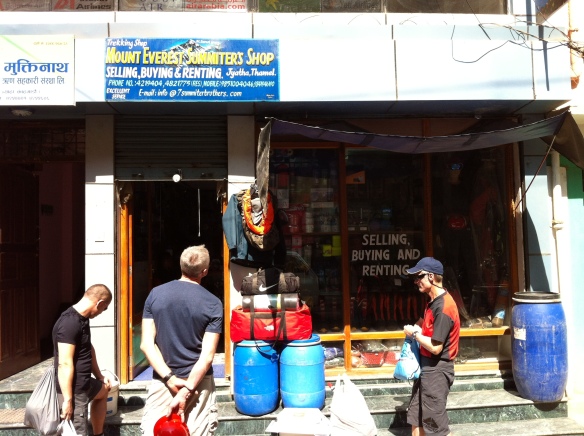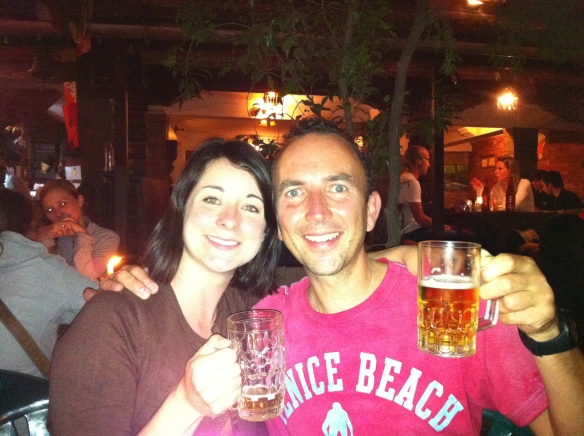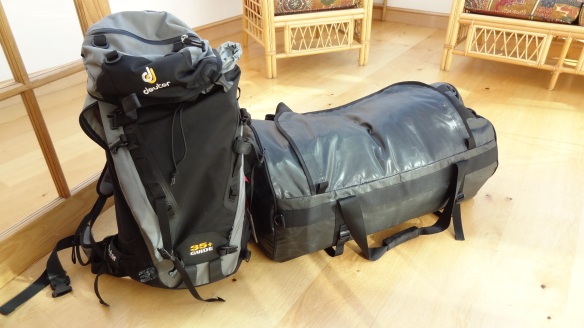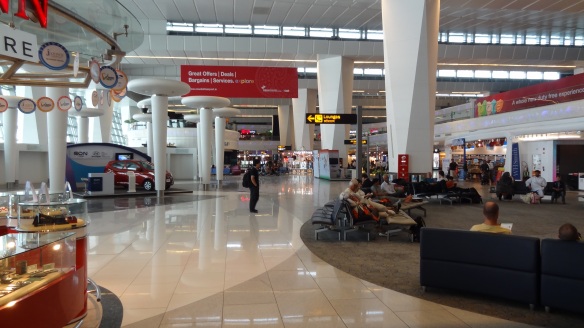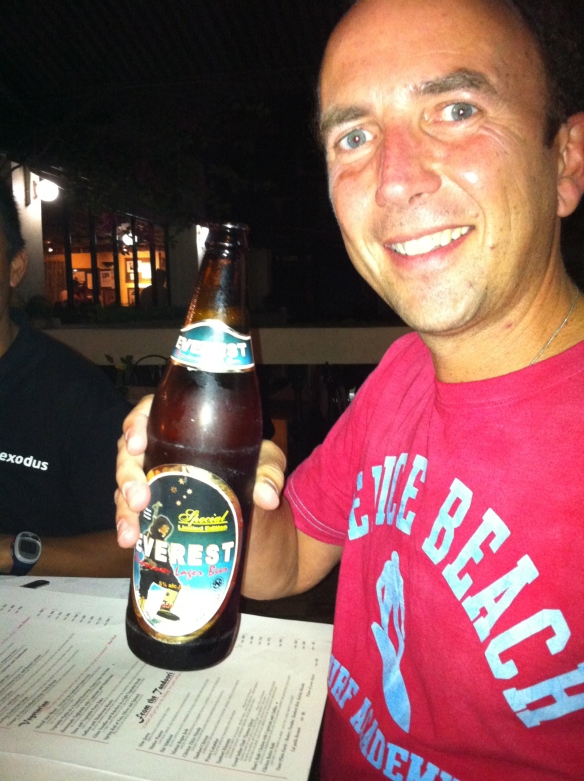So here is a brief overview of the trek which I undertook, and also a few notes on the places and the geography of the place, which I hope puts it all into context:
Under the “Map and Places Visited” section further down there is a pointer to where I went each day, referenced to a copy of the map that I took on trek with me.
Dates
I went on trek on the 19th October 2011, and returned on the 9th November 2011, a total of 22 days. This should be an ideal time for anyone wishing to visit Nepal. It is a principally very dry time of the year, being after the summer monsoon, and the weather is fairly mild for most of the trek.
Climate
Expect (daytime) temperatures of 25C or so In Kathmandu pre trek, and temperatures warm enough for shorts in the Himalayas if the sun is shining for the first few days. Nightime temperatures in the Himalayas will always be below 0C, even in the tea lodges (see below). When you are above about 4,500m, expect even daytime temperatures of below zero. I will talk about kitlist and clothing separately.
Trek Organiser
I went with Exodus Holidays. If you copy and paste this link here: http://www.exodus.co.uk/holidays/tni/overview into your browser you will get all the information you need to tell you if it is the sort of trip for you. There are also trek notes, prices and what have you, in case it piques your interest more to make you wish to do it yourself. I should say that this was the first time I had travelled with Exodus, that I have no affiliation with them whatsoever, and that I found them to be excellent in every regard. I compared Exodus primarily against Jagged Globe before going, and I have no reason to suggest that Jagged Globe would have done a better or worse job. I am still very happy with my choice though.
Brief Overview
My trip was to take in essentially two elements, which are highlighted on the overview map included below:
 The first is a trek from Lukla, at the base of the Himalayas, up though to Everest Base Camp and Kala Pattar, which is (although technically very much a mountain in its own right at 5,545m) the iconic and much celebrated viewing platform for Mount Everest herself. The second would then be an attempt to scale Island Peak, at 6,189m on of the highest ‘trekking peaks’ in the Himalayas. It is called a trekking peak as it is capable of being climbed as part of an organised trek, even though it does involve technical equipment including ropes, jumars, ice axes etc to get to the top.
The first is a trek from Lukla, at the base of the Himalayas, up though to Everest Base Camp and Kala Pattar, which is (although technically very much a mountain in its own right at 5,545m) the iconic and much celebrated viewing platform for Mount Everest herself. The second would then be an attempt to scale Island Peak, at 6,189m on of the highest ‘trekking peaks’ in the Himalayas. It is called a trekking peak as it is capable of being climbed as part of an organised trek, even though it does involve technical equipment including ropes, jumars, ice axes etc to get to the top.
To get to Lukla where the trek, and almost all Everest treks that have ever been, starts, it is necessary to fly from Kathmandu. Once at Lukla you are in the Himalayas themselves. It is at 2,800m, or around 9,500 feet. From here there are no cars, no transport of any kind in fact other than two or four legs. The four legs bit refers to either yaks, or djos (a cross between a cow and a yak, used at lower altitudes), who carry the bulk of the loads throughout the region for trekkers and locals alike.
The region is called the Khumbu, after the glacier and river that flows from the south face of Mount Everest. As can be seen from the maps the geography is all in Nepal, but borders Tibet (in fact half of Mount Everest is in Tibet too), so many of the influences in the region are as much Tibetan and Buddhist as they are Nepalese.
Type of Trek
There are essentially just two types of trek available in the region. You can either camp in tents, or go into tea houses, or combine the two. Most trekkers opt for the tea houses, as they provide a roof over your head, and they also provide hot food, cooked and prepared for you. A typical tea house has a dining room, twin-bedded rooms, and a toilet or two. Some toilets are western style, most are ‘squat’ style. Some toilets are indoor, some are outside. Most lodges don’t have shower facilities, but some do, often just a hut outside where they will pour hot water over you for a few quid. Although there are ‘bedrooms’ you will still need a good sleeping bag to stay there. Our trip was tea house all the way except for nights 13 and 14 below, which were in tents.
The lodges by the average Nepali standards are actually pretty clean, but don’t expect western style cleanliness or warmth. I measured -5 C in my bedroom one night, and running water of almost any kind is fairly rare. They will typically have one heater in the whole lodge, which is a yak dung fuelled stove in the dining room. Be prepared otherwsie, especially higher up, to keep your hat, gloves, thermals and fleeces on inside the lodge. Most have electricity of varying quality, depending upon their solar heaters etc.
Most lodges charge around $1 or $2 a night for you to stay there, and make their money on food. The food is varied, fairly plentiful, and of a good standard.
Overall I was pleasantly surprised at the quality of the lodges that Exodus used. It is fair to say that some of the lodges we saw en route I am glad that we weren’t staying in. It is also very true that the higher you get up the mountain, the facilities get more basic, more expensive, and dirtier as a rule. Again that is to be expected – getting anything up to 16,500 feet will take forever by yak train, so don’t expect a lot.
Map and places visited:
OK so am not sure how easily the above map is to read for you, but if you click it (like all other photographs on my blog) it will expand:) I will explain further below….
The days of travel are as follows:
Day One and two were travelling, and spent getting ready for the trek in Khatmandu.
The days below correspond then with the dates as planned in the trip notes, so the first entry “Himalayas Day 3” is the first day of the trek proper. You will see however from my blog (although I haven’t yet posted it all as I write this) that it didn’t all work out that way for me. This is the way that it was supposed to be therefore.My blog entries will ultimately tell you why things ended up as being different.
The places referred to are more fully described in the individual entries in my blog, and are as marked on the route in yellow on the map above. Most of these places are just settlements of perhaps 20 or 30 houses and lodges, but they vary greatly. Basically again as you get up the mountain everything is less abundant. There are probably 30 lodges and 100 buildings altogether in Lukla, the first and lowest point on the trail at 2,800m. By the time you get to Gorak Shep at the top, I think I saw three building in total. I’ve not provided links, but Google of course is your friend as always.
The distance from Lukla, our starting and finishing point, to Everest Base Camp, is approximately 35 miles, so the total distance covered including Island Peak is probably something like 80-85 miles I would say.
Himalayas Day 3 : Lukla (2,800m, 9,200ft) to Phakding (2,600m, 8,530ft)
Himalayas Day 4: Phakding to Namche Bazar (3,440m, 11,287ft))
Himalayas Day 5: Namche Bazar to Kyangjuma (3,650m, 11,976ft)
Himalayas Day 6: Kyangjuma to Phortse (3,850m, 12,632 ft)
Himalayas Day 7: Phortse to Dingboche (4,400m, 14,436ft )
Himalayas Day 8: Dingboche to Nangkartshang Peak (5,083m, 16,677ft) and back to Dingboche
Himalayas Day 9: Dingboche to Lobouche (4,940m, 16,208ft)
Himalayas Day 10: Lobouche to Gorak Shep (5,180m, 16,996ft), via Everest Base Camp (5,360m, 17,586ft)
Himalayas Day 11: Gorak Shep to Lobouche via Kala Pattar (5,643m, 18,515ft)
Himalayas Day 12: Lobuche to Chukkung (4,730m, 15,519ft) via Kongma La (5,535m, 18,160ft)
Himalayas Day 13: Chukkung to Island Peak Base camp (5,100m, 16,733ft)
Himalayas Day 14: Island Peak Base camp to Island Peak High Camp (5,600m, 18,364ft)
Himalayas Day 15: Island Peak High Camp to Chukkung via Island Peak summit (6,189m, 20,300ft)
Himalayas Day 16: Chukkung to Tengboche (3,900m, 12,796ft)
Himalayas Day 17: Tengboche to Monjo (2,835m, 9,302ft)
Himalayas Day 18: Monjo to Lukla (2,800m, 9,200ft)
After Lukla the trek ends with a flight back to Kathmandu for a day’s recuperation before returning back home to the UK.
If there are any questions or comments on the above, then please let me know – I am always very happy to have feedback or constructive criticism as to how to make it all more useful and/or easier to understand.

























